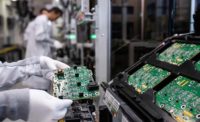Lightweight batteries will be one of the next big breakthroughs in EV technology. One possibility that intrigues engineers is structural batteries, which can be built into the structure of a vehicle’s body or chassis to fulfill load-bearing needs while producing power.
In a conventional battery, the cathode, anode, electrolyte and separator are either stacked or wound around each other in cylindrical or prismatic shapes to fit as much energy as possible into a small space. However, in a structural battery, these components are reconfigured so that the cell can be molded into irregular shapes that can withstand physical stress.
According to some experts, the electrochemical properties of structural devices using lightweight materials, such as carbon fiber composites, could reduce battery masses by as much as 50 percent.
That kind of weight savings potential has attracted the attention of automotive engineers attempting to make EVs lighter and more energy efficient. In fact, several automakers, such as Rolls-Royce, Tesla and Volvo, are already working on projects that involve structural batteries.
Tesla engineers have developed structural battery packs for use in the Model Y. The devices are expected to increase the vehicle’s range by 16 percent and reduce overall weight by 10 percent, resulting in improved acceleration and handling.
According to Sam Abuelsamid, principal research analyst at Guidehouse Insights, Volvo plans to glue prismatic can cells together into one large block and then sandwich it between two metal plates to form the floor of future EVs.
“Volvo claims this approach would enable a more than 20 percent improvement in volumetric energy density in its next-generation batteries,” says Abuelsamid. “Like Tesla, it also claims that this would improve the rigidity of the overall vehicle structure. This is important for safety, but it also contributes to improved ride and handling by providing a more stable platform to attach the suspension to.”
Engineers at Chalmers University of Technology and the KTH Royal Institute of Technology in Sweden recently developed a structural battery that uses carbon fiber to work simultaneously as an electrode, conductor and load-bearing material. It has properties that far exceed anything yet seen in terms of electrical energy storage, stiffness and strength.
Additional research on structural batteries is being conducted by Ahmad Raeisi Najafi, Ph.D., an assistant professor of mechanical engineering at Drexel University. Autonomous and Electric Mobility recently asked Najafi to explain why the technology is so promising.
AEM: What are structural batteries?
Najafi: Structural battery composites are also known as “mass-less” batteries. They are a novel class of multifunctional composites that simultaneously provide mechanical integrity and work as a lithium-ion battery. Structural batteries are currently in the early stages of design. However, they have already been tested in Volvo cars.
AEM: How are structural batteries different than traditional batteries?
Najafi: Traditional batteries are not designed to withstand mechanical loads. The idea of structural batteries is to create devices that can withstand mechanical loads. There are three main differences between a laminated structural battery cell and a conventional lithium-ion battery cell: the active electrode materials are fibers instead of particles; the electrolyte in a structural battery composite cell is in charge of both enabling ion transport between the electrodes and distributing mechanical loads, and it is used instead of liquid electrolyte; and the fibers work as current collectors.
AEM: How could structural batteries improve the range and performance of future electric vehicles?
Najafi: Structural batteries have the potential to address the challenge of “low specific energy” in EVs. One of the primary hindering factors in the development of EVs (and the expansion of their market share) is the low specific energy of batteries, which makes electric vehicles heavy, especially for a long-range design. The specific energy of EVs is much smaller than internal combustion engine (ICE) cars, and EVs have about 10 times more weight allocated to energy storage.
Researchers are pursuing two different approaches to increase the specific energy of batteries and potentially make EVs a competitive alternative to ICE cars. Most groups are trying to directly increase the specific energy of battery cells by reducing the relative weight of inactive components, such as conductive additives, binders, separators and current collectors, or finding techniques to increase the energy density of active materials. The alternative approach to address the low specific energy issue of batteries is to use multifunctional composites that allow for the replacement of some parts of an EV structure with batteries that can withstand mechanical loads. Structural batteries can be seen as a secondary source of energy in EVs.
AEM: When do you expect to see structural batteries become commercially available?
Najafi: This one is tough to answer. In general, more work is required to realize this technology. Ongoing research efforts should develop more competitive solid polymer electrolytes with enhanced mechanical and ion conductivity properties. In addition, new manufacturing and fabrication methods are needed to scale up the production of these multifunctional materials. However, structural batteries will eventually play a vital role in achieving mass-less energy storage in future EVs.
AEM: What issues or challenges still need to be addressed with structural batteries?
Najafi: Structural battery composite is currently in its early stages of development, and there are still a lot of challenges regarding its development process. These challenges are related to the development of electrodes and reinforcements, electrolytes and matrices, fiber and matrix interfaces, design methodologies, fabrication methods, safety and durability. Different groups in Europe and the United States are attempting to address these issues.






